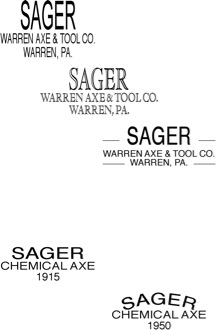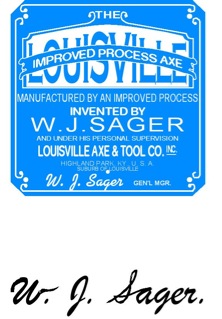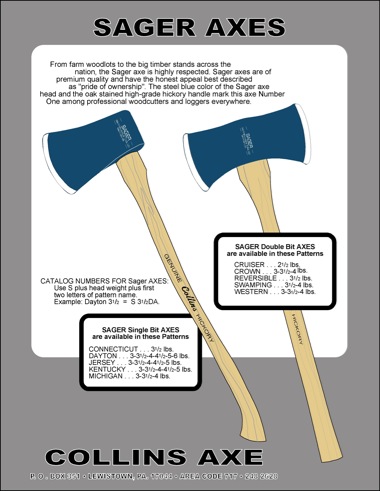




Facsimile of a full page advertisement used by Mann Edge Tool Co. / Collins & Co. post 1966.


SOME HISTORY and INFORMATION RELATED TO WILLIAM J. SAGER AND THE MARKINGS and LABELS ASSOCIATED WITH THE SAGER AXES and CHEMICAL PROCESS AXES
By Tom Lamond ©
Information related to William J. Sager prior to his involvement in the Warren Axe & Tool Company is quite sparse. It is known that he worked for or was involved in more than one company associated with the making of axes. One company was in Ohio and the others were in other parts of the Northeast, possibly North eastern New York State. That was prior to 1893 when he, along with three of his sons and his son-in-law founded the Warren Axe & Tool Co. The three sons that were involved were Frank, W. Ross and Martin Luther. His son-in-law was M. T. Christopher. Whether William J. Sager had additional children is not currently known.
In 1895 William J. Sager, then of Warren, Pennsylvania, was issued a patent for a chemical treatment that was intended to reduce oxidation and prolong the finish of the metal that it was applied to. The process was actually a two part procedure. The first involved dipping the metal to be forged into a chemical mixture and then hammering the metal. That was done when the metal was very hot. The second stage was part of the quenching process implemented when the metal was heated to a red hot color after being tempered. The chemical solution was actually the quenching solution. The end result was a metal tool with a deep lustrous blue coloring that was claimed to be a higher quality and more durable than metal not treated in a similar fashion. The blue coloring itself was protected by a coating of clear finish. Although the process was most commonly associated with axes it was also used on other logging tools made by the Warren Axe & Tool Co.
The exact year that the Warren Axe & Tool Co. started to utilize the process is not clear but is thought to be around the time Sager was issued a patent for the process. It may even have been prior to the actual issuance of the patent. The earliest known labels referring to the process have been dated as being first used in 1895. That label was used until 1912 when it was replaced with a similar label that continued in use until 1950. In addition to the paper labels Sager Chemical Process axes were also stamped with any of a variety of impressions with the name and/or location of the company.
Right around the turn of the century, between 1899 and 1904, another individual became involved in the company. He was Herbert P. Stone and his position was that of “General Manager and Treasurer”. Although the specifics are not known Stone apparently rose to a position where he had the major control of the company. Whether Sager was forced out, bought out or elected to turn over his authority to Stone is not known. In 1912 Stone was instrumental in establishing another similar company in Canada. It was called the Canadian-Warren Axe & Tool Co. and Stone himself was the man in charge. No mention of William J. Sager has been revealed thus suggesting Sager was not involved personally but his Chemical Process certainly was.
Sometime around 1907 or 1908 William J. Sager became involved with another axe manufacturing company namely the Louisville Axe & Tool Co. In their advertisements they included a claim that they used a special chemical treatment that in certain respects affected the metal and protected it from oxidation while coloring it. In that case the final coloring is believed to have been brownish.
A review of patents dated in 1896 (as noted in the advertisements) indicated they did not involve any treatment patent issued to William J. Sager but did refer to one related to the treatment of edge tools. It was issued to William K. Thompson of Alexandria, Indiana.
It is currently believed that Sager procured the right to use that patented process and included a claim for that chemical treatment in the advertisements which in effect may have suggested it was the process commonly referred to as the SAGER CHEMICAL TREATMENT PROCESS. Research has shown that was not the case. The Thompson patent involved a coloring process that resulted in a brown patina being applied to the metal, supposedly to inhibit oxidation.


Labels used on axes made in the U. S.
Labels used on axes made in Canada.
1895-1912
1912-1936
1912-1928
1928-1936
Stamping used by Collins & Co. 1950 - 1955.

Dates on some Chemical Axes have been confirmed for all years between 1915 - 1950. Some stamping included straight lettering, others curved lettering.
Various stampings used on Sager axes made by the Warren A. & T. Co. between 1895 and 1950.
MORE INFORMATION:
Cross reference other articles published on the YesteryearsTools web site that relate to this article;
LOUISVILLE AXE & TOOL CO.
WARREN AXE & TOOL CO.
CANADIAN-WARREN AXE & TOOL CO.

Label used by the Louisville Axe & Tool Co. ca 1908-1915.
Trade Mark Registration No. 71,584; dated December 1, 1908.
issued to the Louisville Axe & Tool Co.


Comments, feedback and additional input are always welcome. Additional information or suggested corrections should be accompanied by verifiable sources or copies of same.
Contact: Tom@YesteryearsTools.com

Click on one of the other topics in the menu box at the top to go to a different department or article.
